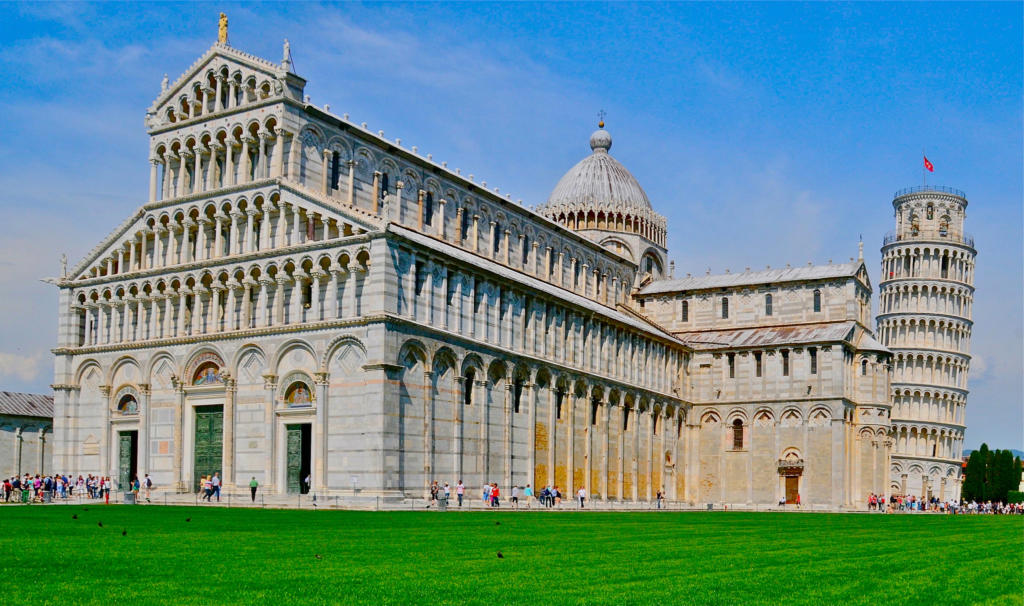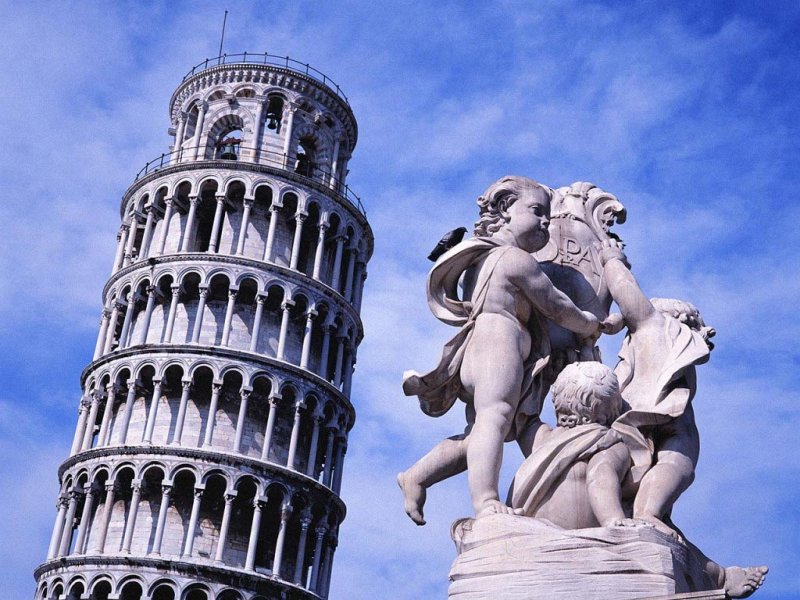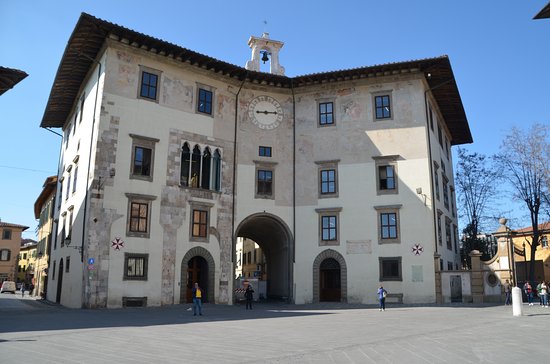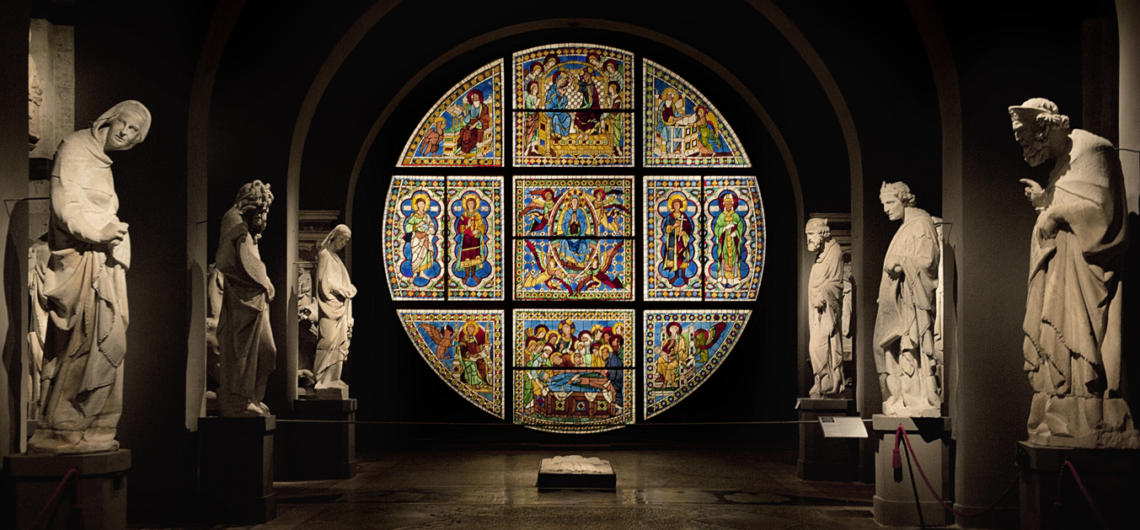Introduction
Unlike the other major art centres of Tuscany, Pisa is practically devoid of great Renaissance monuments for, in fact she made her fortune and accumulated her art treasures mainly during the Middle Ages.
Actually, the peak of Pisa’s economic and political power was reached in the 12th-13th centuries when Pisa ships ruled the Tyrrhenian Sea. It was only during this time that the city, whose prosperity came from lucrative trade with the Orient could afford to commission the masterpieces of painting, sculpture, and architecture with which to embellish herself.
Foremost among these, is, of course, the Campo dei Miracoli, which after almost a millennium has come down to us practically intact except for its celebrated Campanile, the Leaning Tower of Pisa, which every year that passes, is just a bit more leaning.

But you mustn’t make the all too common mistake of thinking that once you’ve seen the Campo dei Miracoli, you’ve seen Pisa.
First Itinerary
• Campo dei Miracoli
• Cathedral
• Leaning Tower
• Baptistry
• Museo dell’Opera del Duomo
• Camposanto
• Museo delle Sinopie
The Campo dei Miracoli
Pisa’s Cathedral Square, known as the Campo dei Miracoli (Square of Miracles) is a veritable miracle of architectural achievement. Four buildings the Cathedral, Leaning Tower, Baptistry, and Camposanto, beautifully shown off their lawn setting, form one of the outstanding architectural complexes in all of Italy.
Their striking stylistic harmony is even more amazing if one considers that it took three hundred years to build them, naturally under the supervision of different architects. Over the centuries few major changes have been wrought, and today we can enjoy the Campo dei Miracoli in all its original splendor.
The Cathedral
Work on the Cathedral was begun in 1064 under the direction of Buscheto (or Buschetto), originally believed to have been Greek, and now known to have been a native Pisan. His mortal remains rest in a simple urn placed behind the first arch on the lefthand side of the façade marked by a commemorative stone.
The unfinished building was consecrated in 1118 by Pope Gelasius II. In the 12th century the façade, designed by Rainaldo, was erected, although construction went on for centuries more. The Cathedral, exerted enormous influence on countless other architectural designs, not only in Pisa, but all over Tuscany and Sardinia as well.

The Leaning Tower
Famous world over, it has come to be the symbol of Pisa.
Unfortunately, its inclinations,now 4.265 meters (13.694 feet), is increasing at the slow but preocupying reate of 1 mm a year. Research on static problems realting to the monument is currently underway, with the hope that a solution may be found before it is too late.
The tower is 179 feet tall on the north side and 177 feet on the south side. From the top, where Galileo Galilei pedormed his experiments on falling masses in the 16th century, visitors can enjoy a splendid view of the city and the countryside around Pisa.

The bell tower was begun in 1173, probably under the supervision of Bonanno. When three floors were already up, the terrain on the south side showed the first sign of sinking and work had to be suspended.
In 1273 the project was resumed by Giovanni di Simone, although it was not completed until the second half of the 14th century by Tommaso Pisano, son of Andrea. The tower is cylindrical, a shape to be found in earlier belltowers in Ravenna on the east coast. Like the cathedral façade, it has a row of blind arches alternating with round arch openings. The Virgin and the Child in the lunette over the entrance was sculpted by Andrea Guardi.

TOURS FROM PISA
• Cinque Terre in Small Group One Day Trip from Pisa
• Tuscan Wine Tour: Wine Tasting Half Day Trip from Pisa
• Siena, San Gimignano & Chianti Wine Full Day Tour small group from Pisa
• Private Chianti and Supertuscan Wine tour in Tuscany
• Florence and Uffizi or Academy (David) Private Tour
• San Gimignano and Volterra Private Day Tour with Wine Tasting
Baptistery (Battistero di San Giovanni)
This dome-shaped chapel has four entrances, a slight lean and incredible acoustics. Since being completed in 1260, it has been of enormous significance to the city.
Indeed, for many years, citizens first had to be baptised here before being able to pray in the Duomo.
Its original architect, Diotisalvi, died long before the building was finished, and the project was handed over the local superstar Nicola Pisano, who added his own ideas to the mix, notably the astonishing marble pulpit that shows vignettes from the life of Christ.
Museo dell’Opera del Duomo
This is a must for sculpture fans as it’s a sort of repository for the city’s great works.
Many of the original pieces from monuments that have at one time or another adorned the Campo dei Miracoli are kept here for preservation purposes, alongside exhibits that are originally from the Duomo.
This represents a fabulous opportunity to get up close and personal to some real works of art

The Camposanto
The Camposanto is the rectangular structure running practically the whole lenght of the north side of the square. The exterior is decorated with the same blind arch pattern used on the other buildings. Over one of the two simple entrances is an elegant Gothic tabernacle by followers of Giovanni Pisano.
The Camposanto was begun by Giovanni di Simone in 1277. It was built so that the mortal remains of the Pisans could be buried in the precious earth from the Holy Land taht archbishop Ubaldo de’ Lanfranchi had actually commissioned the Pisan fleet to transport from Golgotha.
In July 1944 the cemetery was so badly bombed that its lead roof caved in and fused, – in some cases irreparable damage – to the frescoes, sculptures, and sarcophagi beneath the rubble.
The restoration of these treasures was only completed in 1979. Now most of the frescoes have been put back in their original places and their sinopias (underlying preparatory sketches) are on view in a special little museum in the nearby Spedale.
Museo delle Sinopie
A sinopia is a red-powered drawing that is fixed to the wall and used to outline a fresco. This museum shows how the process works and how frescoes are taken down to be restored.
Intriguingly, it contains the original plans for the fresco ornamentation of Camposanto cemetery, which became invaluable when the frescoes themselves fell victim to bombing in World War II.

Second Itinerary
• Ponte di Mezzo
• University
• Piazza dei Cavalieri
• Church of San Francesco
• Church of Santa Caterina
• Museo Nazionale San Matteo
The itinerary starts off from a bridge. Ponte di Mezzo, focal point of Pisan life since time immemorial.
On the right bank of the Arno, the bridge comes out in Piazza Garibaldi. from the square, we turn left into Lungarno Pacinotti and continue along the river. After making a brief pause at the celebrated Caffè dell’Ussero, opened in 1794, on the ground floor of a 15th-century palace, Palazzo Agostini, we turn right into Via Curtatone e Montanara.

The University of Pisa is on this street. Although its façade is modern, the buildings dates back to the 15th century, while the university itself is even older (it is believed to have been in existence since the 1100s).
Throughout the centuries one of the foremost institutions of higher learning in Italy, Pisa University is still a center of great international renown today.
Proceeding, we soon come to the church of San Frediano, set in al little square on our left. Originally built in the 11th-12th centuries, it was greatly altered in the 1600s. The façade is quite simple, with the typical Pisan arcading in the lower section and a two-part window in the upper one. Inside are some 16th-century paintings, a 13th-century Crucifix, and a fine Byzantine-style Virgin and Child, also 13th century, in the chapter house.
TOURS FROM PISA
• Cinque Terre in Small Group One Day Trip from Pisa
• Tuscan Wine Tour: Wine Tasting Half Day Trip from Pisa
• Siena, San Gimignano & Chianti Wine Full Day Tour small group from Pisa
• Private Chianti and Supertuscan Wine tour in Tuscany
• Florence and Uffizi or Academy (David) Private Tour
• San Gimignano and Volterra Private Day Tour with Wine Tasting
Piazza dei Cavalieri
The site of the forum in Roman Pisa, in medieval Pisa the square came to be known as Piazza delle Sette Vie (Square of the Seven Roads) because it stood at the crossroad of seven major arteries.
During the Middle Ages, it was surrounded by Gothic buildings one of which, the Gualandi Tower, is now incorporated into the 17th century Palazzo dell’Orologio.
In 1561 Grand Duke Cosimo I dei Medici had the square altered to make room for several buildings he was having built for the Order of the Knights of Santo Stefano which he himself had recently founded. A 16th-century statue of Grand Duke Cosimo stands by the fountain in front of Palazzo Cavalieri.

The Church of Santo Stefano dei Cavalieri
This imposing building was erected in 1569 by Giorgio Vasari over a pre-existing church. Actually, the façade was put up a few years before Vasari’s project got underway. On either side are low structures, once used by the members of the order as dressing rooms, which, in the 17th century, were transformed into the church aisles.
The Church of San Francesco
Work on the church got underway in the 13th century Giovanni di Simone, the architect of the Camposanto building, is also responsible for the daring design of the belltower, two sides of which rest on huge blocks. The simple façade was erected in the 16th century.

The Church of Santa Caterina
The façade is a typical example of 13th century Pisan architecture. The lower level has three arches with a portal beneath the central one, above which are two rooms of Gothic loggias. Busts of saints (1320) adorn a rose-win dow completed in the modern area.
The Museo Nazionale di S. Matteo
The museum occupies thirty-eight rooms, formerly belonging to an old Benedectine monastery, restored and remodelled in 1949.
The collection was started in the 18th century by Mons. Zucchetti and left to the Cathedral Board of Directors in 1796. Over the years, works from suppressed monasteries and convents and numerous private bequests contributed to the collection’s growth. Today, the visitor can arrive at a good understanding of how art developed in Pisa by carefully following it in chronological order.

Third Itinerary
• Ponte di Mezzo
• Palazzo Gambacorti
• Logge di Banchi
• Church of San Sepolcro
• Church of Santa Maria della Spina
• Domus Galilaeana
• Arsenal
• Church of San Paolo a Ripa d’Arno
Crossing the Ponte di Mezzo to the left bank, we find ourselves in Piazza XX Settembre. The square contains two monuments, Palazzo Gambacorti, whose façade faces the Arno, and the Logge di Banchi.
TOURS FROM PISA
• Cinque Terre in Small Group One Day Trip from Pisa
• Tuscan Wine Tour: Wine Tasting Half Day Trip from Pisa
• Siena, San Gimignano & Chianti Wine Full Day Tour small group from Pisa
• Private Chianti and Supertuscan Wine tour in Tuscany
• Florence and Uffizi or Academy (David) Private Tour
• San Gimignano and Volterra Private Day Tour with Wine Tasting
The Palazzo Gambacorti
This grandiose, yet elegant, mansion was built for a Pisan nobleman, Pietro Gambacorti, between 1370 and 1380. Originally the building was topped by Ghibelline crenellation, but it was torn down when Pisa came under Florentine rule. Remains of Roman columns are visible in the inner courtyard of the palace. Palazzo Gambacorti now serves as the Pisa City Hall.
The Logge di Banchi
The Logge di Banchi was commissioned by Grand duke Ferdinando I dei Medici in the early 1600s. It was built by Cosimo Pugliani, although the design is Buontalenti’s, as a wool and silk market.
Taking Lungarno Galilei from Piazza XX Settembre, after a few blocks, we come to a little square with the church of Santo Sepolcro on the east side.
The Church of Santo Sepolcro
The Templar Knights commissioned Diotisalvi, the architect of the Baptistry, to build Santo Sepolcro around the middle of the 12th century. The octagonal building has the appearance of a solid construction, with a plain façade broken un only by undivided windows and three portals. A pyramidal cusp surmounts the whole.
The Church of Santa Maria della Spina
This tiny building, erectyed in 1323, is a jewel of Pisan Gothic architecture. Its name derives from a reliquary containing a thorn (spina), supposedly from Christ’s Crown of Thorns, once preserved inside.
The building originally stood on the river bank but, constantly threatened by floods and humidity, it was dismantled and set up on a safer spot at strett level.
The exterior of the marble-faced church is elaborately decorated, especially the side facing the Arno. The 13tabernacles on the upper section of the building contain statues of Christ and the 12 Apostles, attributed to followers of Giovanni Pisano. The whole bulding is crowned with intricately-carved spires, and pinnacles, as well as figures of saints and angels. The façade is adorned with two rose-windows and three cusps.
In the tabernacle in the middle are sculptures of the Virgin and Child and two angels by Giovanni di Balduccio. The altar inside the building has sculptures by Tommaso Pisano.

Past the church of Santa Maria della Spina, we come to the Ponte Solferino which we cross, immediately making a right into Lungarno Pacinotti. At Via San Nicola we make a left, go under an arch, and come out in Via Santa Maria, an elegant thoroughfare where many of the university buildings are located.
Immediately on our right, we note the church of San Nicola. Little has been retained, however, of its original 12th-century appearance. Despite its slight tilt, the bell-tower, an eight-sided structure on a cylindrical base, is quite lovely.
Inside the church are a wooden Crucifix, attributed to Giovanni Pisano, and a Virgin and Child, also wood, by Nino Pisano. We continue down Via Santa Maria until reaching the Domus Galilaeana on the righthand side. A center for studies on Galileo and a museum of mementoes of the great scientist, it was founded in 1941.
Opposite is the Museum of Natural History, whose zoological and paleontological collections are especially outstanding.
Retracing our steps back towars the river, we continue along it on the right until reaching the Arsenale delle Galee (Galley Shipyard) which was commissioned in the 16th century by the Knights of Santo Stefano.
A bit father down is the Citadel, a 15th century fortress built by Florentines for the defense of the precious shipyards. crossing back to the left bank by way of the Ponte della Cittadella, we turn left and, passing the Porta a Mare, a city gate, we soon come to Piazza San Paolo a Ripa d’Arno and the church of the same name.
TOURS FROM PISA
• Cinque Terre in Small Group One Day Trip from Pisa
• Tuscan Wine Tour: Wine Tasting Half Day Trip from Pisa
• Siena, San Gimignano & Chianti Wine Full Day Tour small group from Pisa
• Private Chianti and Supertuscan Wine tour in Tuscany
• Florence and Uffizi or Academy (David) Private Tour
• San Gimignano and Volterra Private Day Tour with Wine Tasting
The Church of San Paolo a Ripa d’Arno

This superb example of Pisan Romanesque architecture was actually founded in the 9th century. Over the centuries it has been remodelled several times (The most recent restoration dates from 1943).
Its typically Pisan façade, with a lower section of arcading topped by three tows of loggias, is faced in striped marble.

Best Experience and Day Trips from Pisa to Visit Tuscany and Cinque Terre
• Cinque Terre in Small Group One Day Trip from Pisa
• Tuscan Wine Tour: Wine Tasting Half Day Trip from Pisa
• Siena, San Gimignano & Chianti Wine Full Day Tour small group from Pisa
• Private Chianti and Supertuscan Wine tour in Tuscany
• Florence and Uffizi or Academy (David) Private Tour
• San Gimignano and Volterra Private Day Tour with Wine Tasting
Follow us on Facebook


Comments